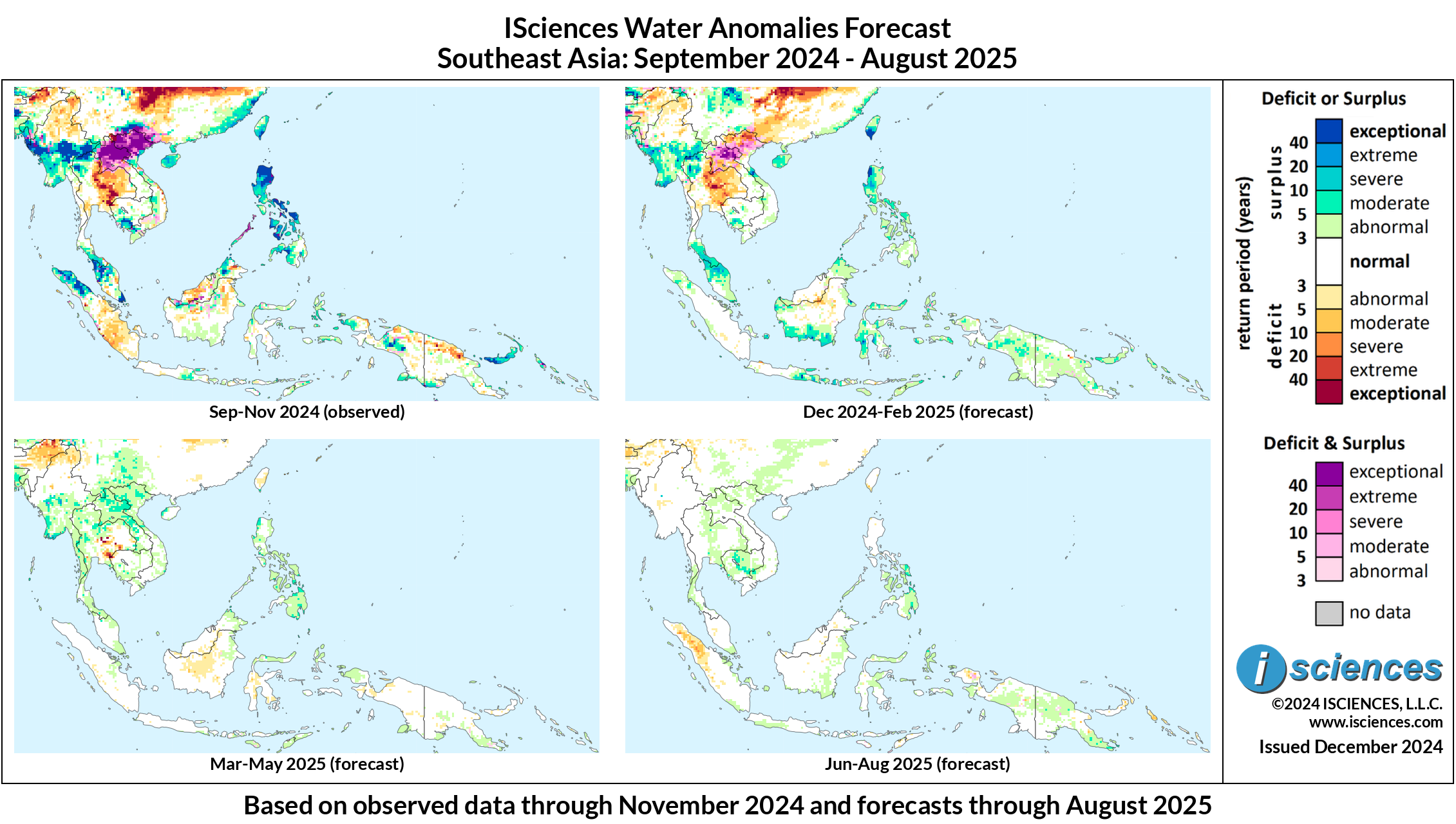Southeast Asia and the Pacific: Pockets of surpluses persist throughout SE Asia
23 December 2024
THE BIG PICTURE
The forecast for the 12-month period ending in August 2025 indicates that extreme to exceptional deficits in Mainland Southeast Asia will mostly resolve. Severe to exceptional surpluses will continue in portions of Maritime and Mainland Southeast Asia.
Severe to exceptional surpluses are anticipated in:
East-central Myanmar, in regions near the city of Taunggyi.
Laos, with the most prevalent anomalies occurring throughout the Houaphanh Province. These surpluses continue east into northern regions of Vietnam bordering Laos.
Philippines, with severe surpluses emerging throughout most central and northern regions of the country.
Southern Thailand, spreading through most southern regions of the Malay Peninsula and into northern Malaysia.
Transitional conditions will emerge in:
Northern Vietnam, throughout areas north of Hanoi.
The 3-month maps (below) show the evolving conditions in more detail.
FORECAST BREAKDOWN
The forecast through February 2025 indicates that severe to extreme surpluses will occur in several regions of Maritime Southeast Asia, including southern coastal Kalimantan, eastern regions of the Lesser Sunda Islands, Sulawesi, and northern Philippines. Areas along the border of southernmost portions of Thailand and northern Malaysia can also expect severe to extreme surpluses. Central and southern Myanmar are expected to observe pockets of severe to extreme surpluses. Central to eastern Thailand is anticipated to endure severe to extreme deficits. Transitional conditions will continue in northern Laos and northern Vietnam, but decrease in size.
From March through May 2025, severe to extreme surpluses in Maritime Southeast Asia are expected to dissipate. Pockets of moderate to severe surpluses are anticipated in central and southern coastal Myanmar, as well as in northwestern Thailand and northern to eastern Laos. Extreme deficits are expected to emerge in pockets within southeastern Thailand.
The forecast for the final months – June through August 2025 – predicts that most of Southeast Asia will observe near-normal conditions with some abnormal surplus anomalies in Cambodia and the Philippines. Northern Sumatra can expect moderate to severe deficits.
Please note that WSIM forecast skill declines with longer lead times.
IMPACTS
Cyclone Gendal devastated regions of southern India, causing 19 casualties – 16 in Sri Lanka and 3 in India. The city of Puducherry recorded its highest rainfall in 30 years, which prompted the army to rescue almost 200 people using boats. Tamil Nadu faced unprecedented rainfall, as rain levels exceeded 40 centimeters in many areas. The deluge left major transport links submerged and halted train services. In Sri Lanka, more than 139,000 families were affected.
After recent flooding in West Bengal, India killed 26 people and displaced 250,000, Chief Minister Mamata Banerjee stated that authorities in nearby Jharkhand worsened the crisis by releasing dam water. The Damodar Valley Corporation (DVC), which manages the dams, stated it had to release water to prevent dam damage, but reduced outflows afterwards as rainfall eased. Some villages like Ghatal were heavily impacted, in whi ch residents relied on boats for transportation.
A new report stated that more than 60% of India's districts are highly vulnerable to floods and droughts, with over 85% of the districts residing in Bihar, Assam, Jharkhand, Odisha, Uttar Pradesh, West Bengal, Karnataka, Tamil Nadu, Chhattisgarh, Kerala, Maharashtra, and Uttarakhand. “We have calculated climate risks by taking into account natural hazards like flood and drought, people’s exposure and their socio-economic vulnerability. The report tells how much and where the resources are to be allocated,” stated Anamika Barua, a researcher from Indian Institute of Technology, Guwahati, and one of the lead authors of the report.
NOTE ON ADMINISTRATIVE BOUNDARIES
There are numerous regions around the world where country borders are contested. ISciences depicts country boundaries on these maps solely to provide some geographic context. The boundaries are nominal, not legal, descriptions of each entity. The use of these boundaries does not imply any judgement on the legal status of any territory, or any endorsement or acceptance of disputed boundaries on the part of ISciences or our data providers.
Subscribe to our monthly Water Watch List
Search blog categories
- *Precip/Temp Outlooks 101
- *Press Releases 1
- *Special Topics 21
- *Water Watch Lists 121
- Africa 130
- Australia & New Zealand 114
- Canada 116
- Central Asia & Russia 114
- East Asia 115
- Europe 121
- Impact Highlights 1
- Mexico & C. Amer. & Carib 119
- Middle East 124
- Proof Point 2
- South America 130
- South Asia 120
- Southeast Asia & Pacific 123
- United States 120
Search blog tags



